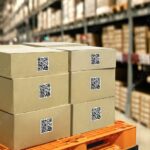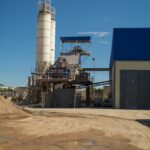The team at Ksapa came together in this webinar to present SUTTI, the Scale-Up Training, Traceability and Impact Initiative. This program combines training and impact investment to address our clients’ concerns. It is in essence a solution to improve socio-environmental practices across agricultural value chains.
Setting the Scene for SUTTI
Smallholders tend to the land in increasingly complex contexts. Climate change, regulatory evolutions, brand demands (labels, etc.), cost restructurations (…) all contribute to make their work more complex. They are nevertheless all too often the last and most isolated link in the value chain. Small-scale producers are faced with increasingly pressing demands, which they are not necessarily equipped to address. Agricultural techniques, good resource management and equipment are just a few of the key areas where they must (rapidly) adapt.
The SUTTI initiative therefore strives to involve different players all along a given value chain. This typically involves industrial buyers, intermediaries, smallholders and territorial as well financial partners. Together, they are in the best position to identify core issues. Convening such “roundtables” allows for the implementation of adapted and actionable strategies, ultimately rekindling trust all around.
For Ksapa, this means securing farmer resilience at the source. That is to say, our teams on the ground work to develop the sustainability of their activities, through positive socio-environmental impact projects. They typically range from knowledge transfer, income and activity diversification to attract young people and mainstream climate and biodiversity preservation practices, reduce accidents or lending access to equipment or quality planting materials…
In the meantime, climate change outright challenges agricultural production and poverty reduction efforts in some regions. Nature-based solutions offer an essential solution and as such have been fully integrated in SUTTI’s operating principles. The program indeed focuses on responsible agricultural practices and resource diversification. The goal? To allow the most vulnerable population to achieve resilience as well as overarching socio-environmental goals.
Addressing Key Risks Reinforced by the Pandemic
Companies Increasingly Held Accountable
Human rights, deforestation, Net Neutrality… Customers and investors alike expect companies to manage their activities and sensitive supply chains in a responsible and sustainable manner.
In parallel, social networks greatly contribute to corporate transparency, if at times at the detriment of a group’s reputation or license to operate. A currently dense regulatory environment likewise pushes companies to do better. They must now more than ever deliver concrete results. In other words, they must demonstrate how their activity benefits both Society and the planet.
Fragmented Value Chains Challenge Full Compliance
That said, implementation remains uneven. Achieving complete compliance is particularly difficult in increasingly fragmented agricultural value chains. In such scenarios, economic players exert little influence individually (sometimes not even collectively). How then can programs be developed and achieve scale in an efficient and relevant manner?
That challenge become all the more acute in the face of Covid-19. The sanitary crisis indeed demonstrated the fragility of global supply chains, casting a rather harsh limelight on companies overly dependent on certain suppliers. A prime example of a weakened market resilience, fashion (and fast-fashion in particular) faced major damage linked to its critically fragmented value chains and reliance on developing countries.
Inadequate solutions
Development projects typically address the different challenges of traceability, risk identification, vulnerable populations’ empowerment and resilience. Lessons learned from the ground up show that, if these projects prove effective on a targeted perimeter, they struggle to achieve scale sustainably and cover entire value chains.
Additionally, lacking consideration of the interests and priority issues of vulnerable segments in particular hinders long-term value creation. To say nothing of fostering trust all along the value chain.
Ksapa’s Approach to Reinvigorating Agricultural Value Chains
To address this prevalent disconnect, Ksapa developed the SUTTI: Scale-Up Training, Traceability and Impact Initiative.
SUTTI’s goal is to benefit vulnerable populations via targeted vocational training. It also aligns with the many interests of different stakeholders all along the value chain. The goal is ultimately to pool the skills, expectations and interests of different players, from farmers, to local manufacturers, global brands, investors, etc. Together, they inform a complete inventory of key agricultural value chains.
This 360-degree analysis is fundamental to the sound implementation of SUTTI projects. It indeed allows for the development of strategies to benefit all stakeholders involved. This common understanding of all their core needs in turn determines how we develop an adapt the SUTTI program. At its core, SUTTI is designed to empower small-scale producers to achieve greater resilience. We do this by delivering vocational training on priority topics ranging from agricultural skills, to health and nutrition, etc. Beyond the benefits its conveys for all participants, this shared analysis also facilitates the activation of various sources of capital.
Ksapa works at the center of the ecosystem. We drive the identification of key value chain players. The SUTTI initiative supports the overall improvement of smallholders’ living conditions, the development of trusted relations between local suppliers and industries. This way, brands may shore up their commitments. Investors can put capital to work and track its impact. This in turn fosters the very traceability and responsibility they are increasingly expected to demonstrate.
Introducing SUTTI, the Scale-Up, Training, Traceability and Impact Initiative
3 modules, 1 solution
The SUTTI solution operates around 3 complementary modules:
- The design and operational implementation of training programs in the field, thanks to a large network of local partners;
- A digital solution specific to Ksapa to deliver training programs. The SUTTI digital suite is designed to be accessible and inclusive of all and adaptable to all geographies and commodities;
- An impact investment management solution to activate all possible financial levers. In support of industrial buyers’ operations, among others, this allows us to leverage economy and offsetting as well as blended finance schemes, etc.

The SUTTI initiative can activate all 3 modules, in concert or independently. Several funds may support one or more companies in improving their resilience and adapting their value chain. This translates into hybrid training programs that effectively combine with face-to-face sessions and the use of a digital application.
These modules can nevertheless operate separately. For example,
- The implementation of a hybrid training program can be done without the support of investors, in a pilot phase or for a program targeting a very targeted population;
- An exclusively face-to-face training program can be conducted, especially in regions with little or no access to cell phones and networks.
Field Support for Vulnerable Populations
Poor quality? Questionable environmental practices? Severe poverty and social issues? Farmers are the key link in most of the social, environmental and ethical issues that plague supply chains. Though not the only actionable lever, knowledge transfer is key for these farmers to improve their practices. This in turn supports the betterment of socio-environmental and ethical performances all along the supply chain.
Still, activating these skills requires time and training, which smallholders may no necessarily have access to. The SUTTI digital suite is precisely designed to address this bottleneck. This tool indeed allows farmers to capitalize on their know-how and learning from the (short) face-to-face sessions. With the digital application, they may progress independently, based on their availability. The content is furthermore accessible on any cellphone equipped with a web engine. The training content that can be opened without a connection and is delivered in the farmers’ language, with practical visuals adapted to his crops. With this content, farmers may chose to allocate time to access the basic training only, or pursue further learning.
Vizualizing SUTTI Impacts on Smallholders
SUTTI’s positive impacts on smallholder income are typically indexed to the local minimum income. With that in mind, Ksapa can also leverage the results of its initial 360° analysis to identify which levers to activate to contribute to farmers’ income diversifications. That said, increasing yields and reducing costs are the first 2 levers that can be used, regardless of the area or commodity.
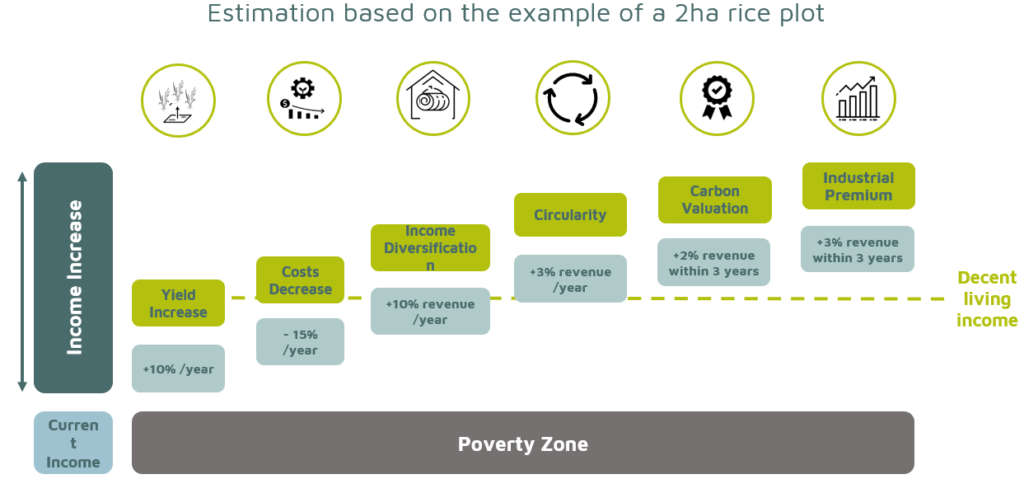
The levers presented above are those identified in the projects that Ksapa is currently conducting in the field. The SUTTI approach is unique in that it offers a hybrid training program, capable of combining classroom and digital learning. This format makes SUTTI an inherently scalable solution. It also lends itself to translation and adaptation to various countries and commodities.
The SUTTI Digital Application
The SUTTI application supports program scale-up. The application can indeed reach more beneficiaries and helps measure program roll-out and impact. For ease of use, the application is simple and visual. It can be accessed from basic smartphones without necessarily requiring network access (except for downloading).
The SUTTI suite includes 3 modules, each adapted to the needs of their respective users. First, the e-learning app allows participants to access the training program. Second, the digital dashboard allows sponsors (brands, investors, etc.) to follow the program roll-out and impact. Finally, the back-office assists instructors in running the program on the ground.
The E-Learning App
The e-learning module was developed with training participants in mind. As such, it stands at the heart of the SUTTI program.
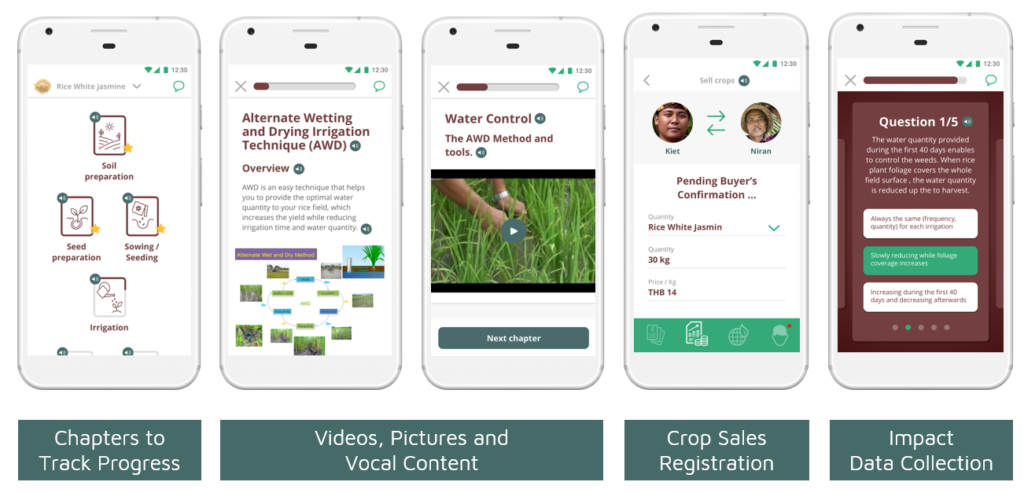
This module lends access to :
- Training relevant to the local context, farmers’ work and their needs, thanks to videos, definitions, technical presentations…
- A “studies” section where smallholders’ participation in surveys complements the program’s central database. This makes it easy to track the positive impact of the training, especially on yields, living conditions, etc.
- A transaction tracker, for smallholders and other participants (sponsors, trainers) to monitor their evolution over time.
- This support is provided entirely in the user’s language. Different functions include text vocalization should they have any difficulty to read (illiteracy, degraded sight, external activities in bright environments, for example).
The Digital Dashboard
The digital dashboard is intended for buyers and investors. It allows them to seamlessly track the different components of the program. It also allows players to quickly visualize the social, environmental and economic impacts of SUTTI.
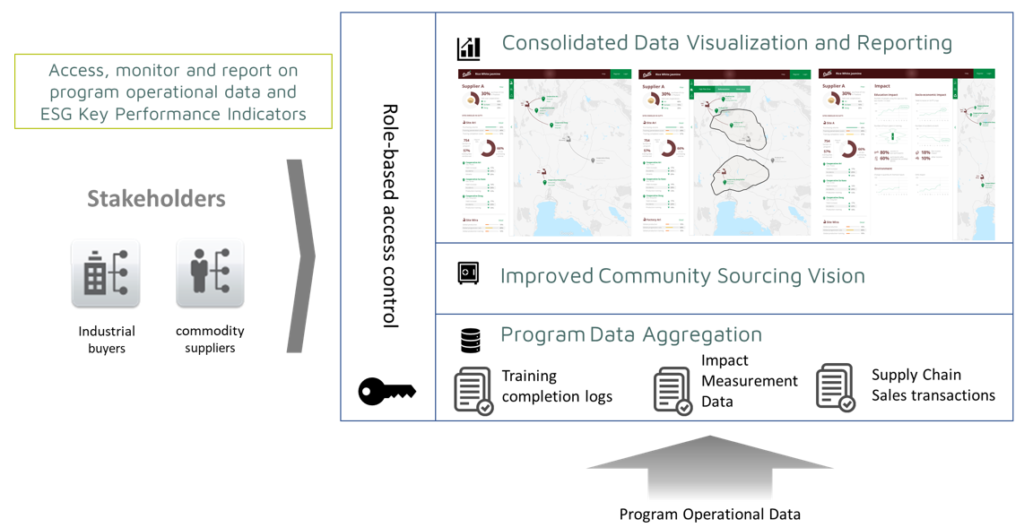
- This interface provides an aggregated and anonymized view of program participants. When linked to indicators, it supports the monitoring of the program roll-out;
- This interface cab focus on certain geographical areas, in order to verify risk reduction in relation to specific local issues – deforestation, for example;
- Finally, impact indicators structure the monitoring of the SUTTI program’s effectiveness. It zeroes in on best practice adoption or operational performance in line with core objectives. These may range from income increases and diversification to poverty eradication, intrant reduction, ending work-related accidents, or cutting water consumption, for example.
The Back-Office
The back office is a practical tool. It allows the different trainers to ensure all operational aspects related to the training. In particular, it supports the registration of participants, the follow-up on the use of the e-learning module, etc. It also integrates carbon information tools, allowing the implementation of carbon calculation and credits scheme development.
That said, while the SUTTI program is intended to achieve financial sustainability over time, it requires initial investments.
Financing the Scale-Up, Training, Traceability and Impact Initiative
The SUTTI program supports the rapid activation of solutions in the field, in a logic of long-term value creation. Ensuring all stakeholders involved tap into its many benefits entails a convergence of agendas among farmers, industrial players and impact investors. To achieve this, Ksapa relies on an important local and international network of partners who support program roll-out.
Today, SUTTI’s business model is adaptable, depending on the geographical area and target commodity. The financial structure of the SUTTI program was designed so that initial investments may progressively gain in impact over time. We do this by combining different revenue levers; which is how we foster program scale up and reach a growing number of people. Positive impacts identified therefore include financial returns and social and environmental impacts (as certified by a third-party organization).
Conclusion
A 100% face-to-face training solution is often weighed down by high fixed costs, which challenges its long-term sustainability. On the other hand, a fully digital training initiative would fail to adapt to the realities of the field. The SUTTI program, with its hybrid formula, offers the right balance to mobilize farmers, achieve scale and verify program impact in the process.
Engaging with various value chain players from the get go fosters trust all around. The operational training implementation and the digital suite are what makes SUTTI such a unique tool. It allows players to follow its social, environmental and economic impacts in real-time. The data collection and visualization modules also benefit the entire value chain.
SUTTI currently focused on agricultural commodities. Its flexible structuring and its central training vocation allows Ksapa to adapt the SUTTI initiative to industrial projects centered on health, safety or living conditions, for instance. The underpinning 360° analysis and engagement of supply chain players indeed allows for various iterations of SUTTI to address key issues, identify priority levers and ultimately improve vulnarable populations’ working and living conditions.
Sona is a Consultant for the Advise team at Ksapa.
She graduate in international development from Sciences Po Paris, and has worked on sustainable models within a diverse number of industries. Previously based in Kuala Lumpur, Sona has also tackled social and societal issues for Total and the Galeries Lafayette Group and has analyzed the implementation of the Chinese carbon market from Beijing. Her experience in different markets have helped her use a global approach when building a sustainable performance.

